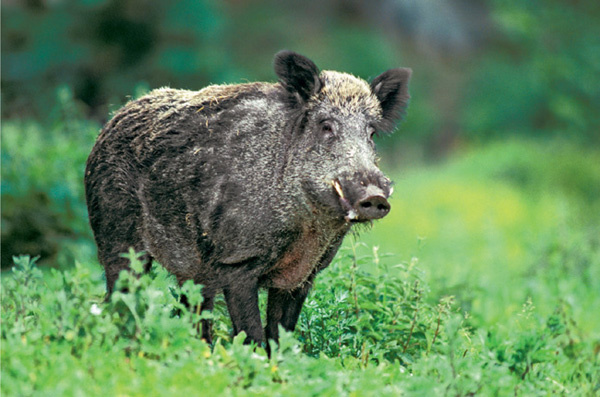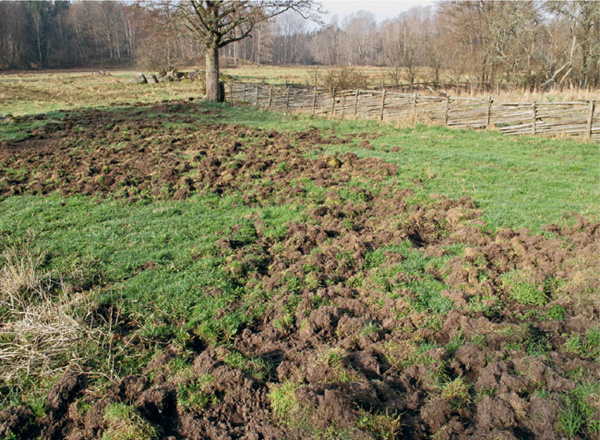
Sus scrofa
The Wild Boar is a powerfully built animal with a compact body and large triangular head. It has strong legs and can run fast. The female, a sow, can weigh 55–100 kg; the male, the boar, is larger and normally weighs 65–150 kg, but an old male can weigh more than 200 kg. The height at the shoulder is 85–100 cm.
Wild Boar prefer mixed deciduous woodland with swamps and water holes, often with a mix of fields, meadows, or moorland nearby. Sows and young live in herds; the males are solitary except during the mating season in winter. Wild Boar have long, sharp canines in the lower jaw that can reach 20 cm in length and protrude well out of the mouth.
The young have a light brown coat with dark stripes; adults and juveniles are dark grey.
Wild Boar feed mainly on plants, mushrooms, roots, bulbs, grain, maize, acorns, beechnuts, and chestnuts as well as fruit; they also eat worms, snails, insects, and larvae, as well as mice and other rodents. They also plunder bird nests on the ground and feed on carrion as well as killing fawns and young Rabbits.
The powerful canines of a large male Wild Boar. LG.

Wild Boar can cause extensive damage to fields when they root for food or eat crops such as maize, oats, turnips, and potatoes.
Baby Wild Boar are striped. Biopix.

Wild Boar tracks with the print of the dew claw visible in mud at a wallow. JK.

Wild Boar have hooves like deer. They have four toes; the middle two are large, while the two dew claws are much smaller but normally visible in footprints irrespective of the animal’s gait. In older individuals, the large hooves have rounded edges. In footprints, you can see that the dew claws are placed more laterally and closer together in Wild Boar than in deer. In adults the print is 5–8 cm long and 4–6 cm wide; deer tracks are narrower and more elongated. The stride is 20–40 cm, but Wild Boar will switch quickly from walking to running.
Wild Boar can root up ground so badly with their snouts that crop cultivation is not possible. AK.

Wild Boar herds are often led by an old sow. You can identify the herd’s tracks quite easily, especially in the snow, and see where members of the herd have followed one another in a line. With their strong snouts Wild Boar root through the top layers of soil looking for snails, roots, worms, and insect larvae, and in the process may plough up extensive areas. These tracks are clear evidence of Wild Boar activity.
Wild Boar scat smells sweetish. L-HO.

Wild Boar do not kill large animals themselves, but they gladly feed on carrion—here an Elk. L-HO.

The scat is sausage-shaped, 7 cm thick and about 10 cm long. It is normally found in cohesive clumps, similar to the summer scat of deer. The scat is black but may turn grey after a while.
Wild Boar love to wallow in mud and water to rid themselves of irritating parasites and to protect their skin from biting insects. You often see prints and scat at these wallows. There is usually a strong, distinct smell of the animal at a recently used wallow.
Wild Boar are very shy, but they can sometimes be surprised out in the open. PFM.

When a boar has wallowed, it rubs itself on large stones or nearby trees. The tree trunk may then appear completely smooth (cf. p. 53). Occasionally, marks from their canine teeth or long, greyish black hair might also be found.
Wild Boar are mostly nocturnal; during the day they lie in well-hidden rest sites on the forest floor that may be cushioned with grass and leaves.
Wild Boar are animals of the forest. PFM.

A pregnant sow prepares a large nest with grass stalks, ferns, and branches for the time when she will give birth; initially she raises the young, but after a few weeks, they can feed independently and follow her in the forest.
A herd goosesteps through deep snow.
